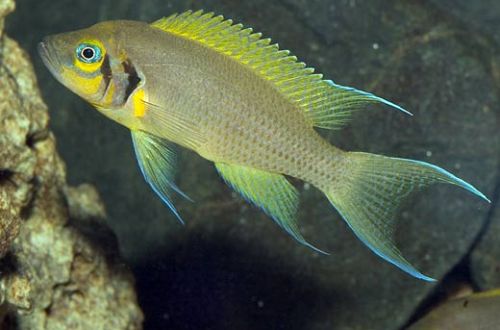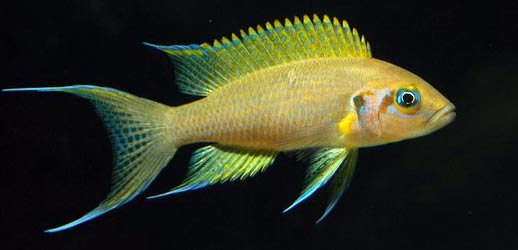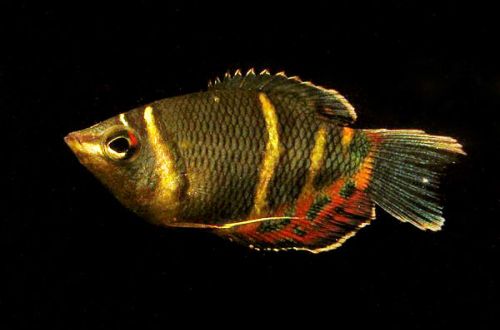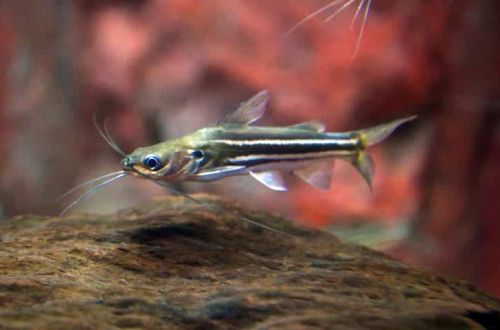
“Princess of Burundi”
Cichlid “Princess of Burundi”, Neolamprologus pulcher or Fairy Cichlid, scientific name Neolamprologus pulcher, belongs to the Cichlidae family. It got its name from the area where it was first discovered – the coast of the lake belonging to the state of Burundi.
It is considered one of the most popular cichlids of Lake Tanganyika, due to the relative ease of keeping and breeding. In large aquariums, it is able to get along with representatives of other species.

Contents
Habitat
Endemic to Lake Tanganyika, one of the largest on the African continent. It is found everywhere, prefers coastal regions, the bottom of which is dotted with rocks.
Brief information:
- The volume of the aquarium – from 50 liters.
- Temperature – 24-28°C
- Value pH — 8.0–9.0
- Water hardness – medium to high hardness (8-26 dGH)
- Substrate type — stony
- Lighting – moderate
- Brackish water – no
- Water movement – weak, moderate
- The size of the fish is 7–9 cm.
- Nutrition – high-protein feed
- Temperament – conditionally peaceful
- Keeping in a pair or in a harem with one male and several females
Description

Adult individuals reach a length of 7–9 cm. Sexual dimorphism is weakly expressed. Males, unlike females, are somewhat larger and have elongated tips of the dorsal and caudal fins. The coloration is gray with yellowish hues, most clearly manifested on the head and fins, the edges of the latter, in turn, are painted in blue.
Food
The basis of the diet should be live or frozen foods, such as brine shrimp, bloodworms, daphnia, etc. Dry food with herbal supplements (flakes, granules) are used as a supplement, as a source of vitamins and trace elements.
Maintenance and care, arrangement of the aquarium
The size of the aquarium for keeping one or two Princess Burundi cichlids can start from 50-60 liters. However, if breeding or mixing with other fish is planned, then the size of the tank should be increased. A volume of 150 or more liters will be considered optimal.
The design is simple and consists mainly of sandy soil and heaps of stones, rocks, from which crevices, grottoes, caves are formed – because this is what the natural habitat in Lake Tanganyika looks like. There is no need for plants (live or artificial).
Successful long-term management depends on the provision of stable water conditions within an acceptable temperature and hydrochemical range. To this end, the aquarium is equipped with a filtration system and regular maintenance procedures are carried out, which include: weekly replacement of part of the water (15-20% of the volume) with fresh water, regular removal of organic waste (food residues, excrement), equipment prevention, concentration control products of the nitrogen cycle (ammonia, nitrites, nitrates).
Behavior and Compatibility
Refers to territorial species. During the spawning period, males become especially intolerant of each other, as well as of their tankmates, perceiving them as a potential threat to their offspring. In a small tank, only representatives of their own species are allowed, for example, one male and several females. If there is enough space (from 150 liters), then two or more males can get along together with females, as well as representatives of other species from among the inhabitants of Lake Tanganyika.
Breeding / breeding
Breeding is quite simple. Pisces show amazing parental care, which even other members of the group join in. Male and female form a stable pair that can survive for a long time. This type of cichlid finds a partner on its own, so you will either have to find a formed pair, or make it appear on its own. For purchase a group of 6 or more young fish. As they grow older, at least one pair should form among them. As noted above, in a small aquarium, it is better to remove an extra male.
With the onset of the mating season, the fish find a suitable cave for themselves, in which spawning will take place. The female lays about 200 eggs, attaching them to the wall or vault inside the cave, and remains next to the clutch. The male at this time guards the surroundings. The incubation period lasts 2-3 days, it will take another week for the fry to swim on their own. From this point on, you can feed food such as brine shrimp nauplii or other products intended for juvenile aquarium fish. The parent protects the offspring for some more time, and other females can also take care. The younger generation becomes part of the group, but over time, when puberty is reached, young males will have to be removed.
Fish diseases
The main cause of diseases lies in the conditions of detention, if they go beyond the permissible range, then immunity suppression inevitably occurs and the fish becomes susceptible to various infections that are inevitably present in the environment. If the first suspicions arise that the fish is sick, the first step is to check the water parameters and the presence of dangerous concentrations of nitrogen cycle products. Restoration of normal/suitable conditions often promotes healing. However, in some cases, medical treatment is indispensable. Read more about symptoms and treatments in the Aquarium Fish Diseases section.




